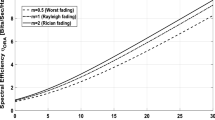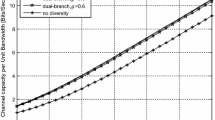Abstract
This paper presents the error probability performance for M-ary quadrature amplitude modulation (mqam) signalling with L-branch diversity receiver over Nakagami fading channel. Both maximal ratio combining (mrc) and selection diversity combining (sdc) techniques are considered with reference to predetection diversity architecture, in the case of integer values of fading severity and independent fading. Average symbol error probability is analitycally derived in terms of finite sum of Gauss hypergeometric functions for balanced branches with identical values of the fading severity. In particular, performance analysis of sdc for mqam in Nakagami fading is new since it has not been presented in any previous work. Numerical results are presented allowing to identify those operational conditions in which diversity techniques can aid successfully in counteracting the effects of slow and nonselective short-term fading.
Résumé
Ľarticle étudie la probabilité ďerreur du maq m-aire qui est obtenue avec une diversité à l branches. Il analyse les combinaisons de signaux à rapport maximal (mrc) et à sélection (sdc) avant détection, pour des valeurs entières de la sévérité ďévanouissement et des évanouissements indépendants. La probabilité ďerreur majeure par symbole est exprimée analytiquement par une somme finie de fonctions hypergéométriques gaussiennes pour des branches équilibrées ayant des valeurs identiques de sévérité ďévanouissement. Ľanalyse est originale dans le cas sdc. Des résultats numériques permettent ďidentifier dans quelles conditions opérationnelles les techniques de diversité sont efficaces contre les effets ďévanouissements lents non sélectifs.
Similar content being viewed by others
References
Nakagami (M.), Them-distribution — A general formula of intensity distribution of rapid fading,Statistical Methods in Radio Wave Propagation,Hoffman (W.G.) Editor,Pergamon Press (1960), pp. 3–36.
Charash (U.), Reception through Nakagami fading multipath channels with random delay,IEEE Trans. on Communications (1979),COM-27, pp. 657–670.
Miyagaki (Y.), Morinaga (N.), Namekawa (T.), Error probability characteristics for cpsk signal throughm-distributed fading channel,IEEE Trans. on Communications (1978),COM-26, pp. 88–100.
Turin (G.L.), Jewell (W.S.), Johnston (T.L.), Simulation of urban vehicle monitoring systems,IEEE Trans. on Vehicular Technology (1972),VT-21, pp. 9–16.
Suzuki (H.), A statistical model for urban radio propagation.IEEE Trans. on Communications (1977),COM-25, pp. 673–680.
Al-Hussaini (E.K.), Al-Bassiouni (A. A. M.), Performance of mrc diversity systems for the detection of signals with Nakagami fading,IEEE Trans. on Communications (1985),COM-33, pp. 1315–1319.
Fontan (F.P.), Castro (M.A.V.), Kunisch (J.), Pamp (P.), Zollinger (E.), Buonomo (S.), Baptista (P.), Arbesser (B.), A versatile framework for a narrow and wide-band statistical propagation model for the LMS channel,IEEE Trans. on Broadcasting (1997),43, pp. 431–458.
Lu (J.), Tjhung (T.T.), Chai (C.C.), Error probability performance ofL-branch diversity reception of mqam in Rayleigh fading,IEEE Trans. on Communications (1998),46, pp. 179–181.
Annamalai (A.), Tellambura (C.), Bhargava (V.K.), Exact evaluation of maximal-ratio and equal-gain diversity receivers for M-ary QAM on Nakagami fading channels,IEEE Trans. on Communications (1999),47, pp. 1335–1344.
Proakis (J.),Digital Communications, 2nd Ed., McGraw-Hill (1989).
Abramowitz (M.),Stegun (I.), Handbook of Mathematical Functions, Dover (1970).
Fedele (G.), N-Branch diversity reception of M-ary dpsk signals in slow and nonselective Nakagami fading,ETT — European Transactions on Telecommunication (1996),7, pp. 119–123.
Gradshteyn (I.),Ryzhik (I.),Tables of Integrals, Series and Products, 5th Ed., Academic Press (1994).
Author information
Authors and Affiliations
Corresponding author
Rights and permissions
About this article
Cite this article
Fedele, G. MQAM Performance over Nakagami channels with diversity. Ann. Télécommun. 56, 78–84 (2001). https://doi.org/10.1007/BF03002988
Received:
Accepted:
Issue Date:
DOI: https://doi.org/10.1007/BF03002988




